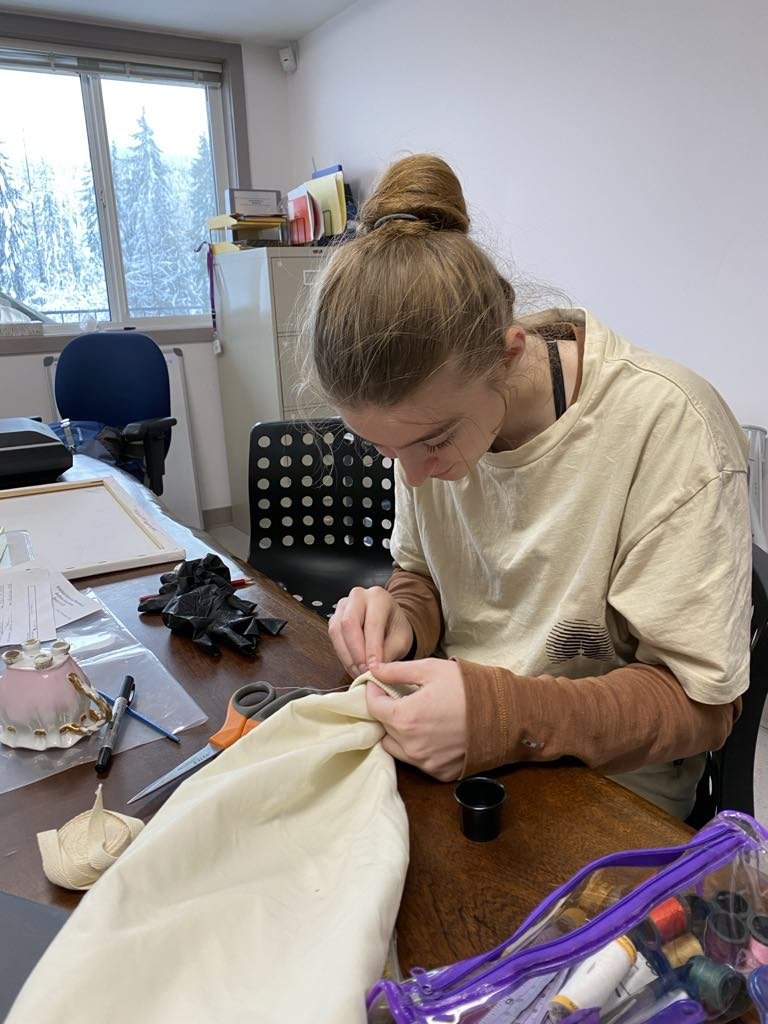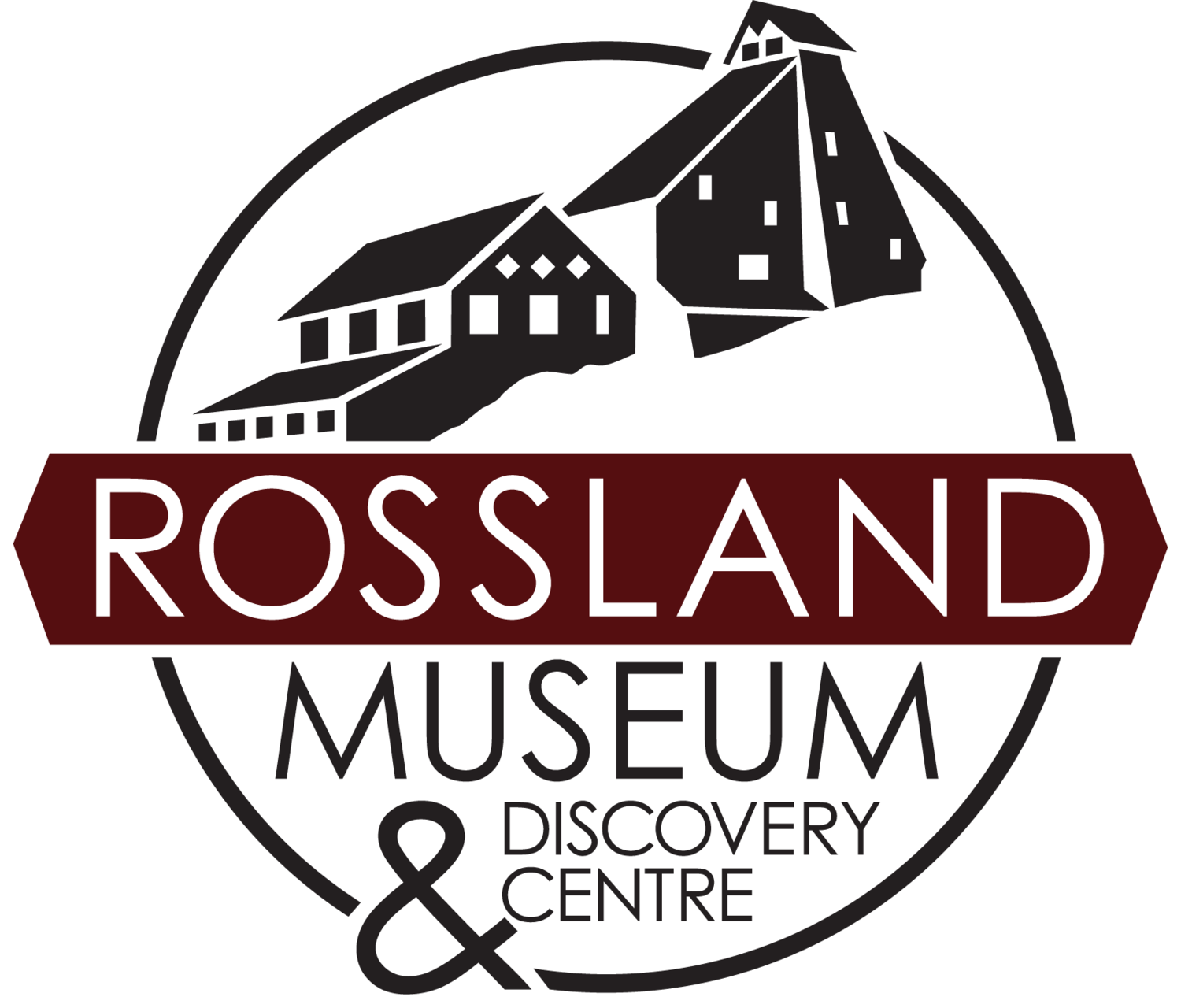Behind the Scenes: Collections Coordinator Spotlight with Hannah Klemmensen
Working as the museum’s Collections Coordinator Intern the last five months has been a wonderful and incredibly educational experience. My time has been split between four key projects alongside many other smaller ones. These projects have allowed me to learn and grow in diverse ways - from caring for objects in the museum collection, to curating exhibits, to describing the texture of rocks!
- Hannah
The Rossland Museum & Discovery Centre would like to thank the Government of Canada and the Canadian Museums Association's Young Canada Works program for contributing to this paid internship opportunity.
Key Projects
Winter Carnival Outreach Exhibit: Spills and Thrills!
A large portion of the first half of my internship went to preparing an outreach exhibit to be displayed downtown during the 2025 Rossland Winter Carnival. When Sara (Collections Manager) suggested an exhibit on the Sonny Sameulson Memorial Bobsled races, I was immediately hooked! Growing up in Rossland, these races have always been the highlight of the Carnival for me, and I was keen to learn more about their history. However, a quick look through our archive and object collection made me realize why no exhibit had been made about these races before! The community had yet to donate any artifacts, less than a handful of confirmed photos, and almost no recorded history of the races. I decided to take this as a challenge and an opportunity to try and preserve a little piece of my town’s history close to my heart. Thus kicked off several months of combing through the museum’s archival newspaper collection, reaching out to knowledgeable community members, and receiving many generous donations of photos, knowledge, and artifacts from the community.
A2022.000.004.001a: Three Museketeers bobsled team at the 1949 Rossland Winter Carnival bobsled rates. The research process was full of many exciting ‘a-ha’ moments, and this photo was one of them. We had a copy of this photo in our archives but no information about it. I wasn’t even sure if it really was from an early bobsled race or not. Flipping through old copies of the Rossland Miner newspaper, I found the same photo printed in the paper with a caption explaining the context!
I’m very proud of my efforts, which culminated in the creation of an exciting outreach exhibit. The information from this exhibit also lives on in the companion essay I wrote: Thrills and Spills! Rossland Winter Carnival’s Bobsled Races.
Because of the way this project snowballed, I learned many more skills than I expected from it. Preparing the exhibit was an excellent experience in writing engaging exhibit text, a form of accessible and brief education writing that I appreciated the chance to try my hand at. I also learned how to construct exhibit panels and the basics of curating an exhibit display. On top of this, through receiving donations from the community, I learned a lot about the museum’s archival system and how to add new items, how to digitize photos, as well as the process of accessioning new objects into our collection. Conducting research to discover more about the races also provided me with additional experience in researching effectively in a community archive.
The 2025 Rossland Winter Carnival outreach exhibit: Thrills and Spills!
The “Hill of Fame” displaying mini replicas of some of the famous bobsled teams. Whenever you have the chance to be paid to make paper mache, you should take it! The idea for creating a hill came to me after I realized we didn’t have existing artifacts or display pieces that would entice people to stop and check out the display. In the end, generous community donations meant there were many exciting peices to put out in addition to this hill!
Accessioning New Donations
Another key project I worked on throughout my internship was the accessioning of new donations into the object collection. This entailed ensuring that when a donation is received, the paperwork is managed and stored properly, the object is labelled with a unique accession number, and all information is added to the digital register of objects in the museum. After this, I worked to catalogue the objects - describing their history and context (provenance), assessing any damage or issues to be aware of, photographing them, and entering all information and the photos into the collection management software (PastPerfect).
The museum recently received a large donation from a local family, containing many household and beauty items from the early 19th century. Among these items were these two small, painted plates, which, according to the family’s understanding, were originally from a brothel in Rossland.
Cataloguing the Collection
An ongoing project I contributed to was cataloguing the existing object collection. Cataloguing involves visually inspecting an artifact and writing detailed descriptions, making note of its condition, and providing additional information about its provenance (the story of its life and how it came to the museum). It also involves taking multiple photos of the artifact and entering everything into the collections management software (PastPerfect). This is an important part of collections management, as some objects may have been assessed upon arrival but not for several years. Further, as industry standards change, there is a need to review the way information about them has been recorded and attended to in case anything should be updated. This cataloguing is also the process by which the object collection is slowly being added to the digital software PastPerfect. PastPerfect is not only a wonderful tool for the management and care of the collection, but excitingly, this software has an online database function that allows the public to view all these objects via our Community Collection Portal.
Accessioning new donations and cataloguing existing collections taught me many valuable skills about museum care. These projects gave me a chance to learn the basics about different risks and agents of deterioration in museums that can harm artifacts, such as light, humidity, and pests. I got to see the processes the museum has in place to mitigate these risks and ensure good care of the collection, as well as began to learn how to spot potential issues affecting items and think through how to manage these challenges long-term. These tasks also allowed me the chance to learn about photography. While I am by no means an expert, after this internship, I now understand the importance of taking clear photos, as well as some of the basic settings on a professional camera. They also gave me the chance to learn about and use the PastPerfect software.
One of my favourite parts of the accessioning process is labelling objects, or as I like to call it, my “arts and crafts” days. Each item requires thinking through the best method of labelling to limit any permanent damage to the object and to allow removal with as minimal permanent impact as possible in the future, if needed. The same recent donation mentioned above is a perfect example of the many different ways to label an artifact - from simply attaching a tag to applying a water soluble resin layer to write on (as is done for the teacup), to sewing in cloth labels for fabrics.
Managing the Found in Collection Geological Specimens
Over the years, the museum has received a substantial amount of rocks and minerals, some of which have been well labelled and accounted for, others less so. As a result, the museum is managing a substantial collection of “Found in Collection” geological specimens - rocks and mineral specimens whose history and data, particularly about how they made it to the museum, has become lost. Through my internship, I was excited to support the ongoing project of managing these rocks. This included attempting to identify the specimens, assigning and labelling them with unique accession numbers, taking photographs of them, and uploading them to PastPerfect.
This work was necessary to prepare for a collection move to a new geology storage system (funded in part by the Province of BC) as well as preparing for the display needs of Rossland specimens through the Renewal Project’s Mine Experience and Assay Office exhibits - coming soon!
One of my favourite finds in the geological collection was these two calcite pseudomorphs, also known as glendonite. Pseudomorphs are formed when one mineral takes the place of a previous one, and therefore, also takes on the shape of that original mineral - similar to the process of a mineral taking the place and shape of an organism, forming a fossil. These pseudomorphs likely came from the Canadian Arctic and took the shape of iakite. Iakite forms in very specific cold water conditions; therefore, when those conditions changed slightly, they were replaced with the more resilient calcite!
Another very cool specimen that I came across in my cataloguing! This rock is pyroclastic. This means that it formed from magma exploding out of a volcano. Its strange shape is the result of this molten rock beginning to harden in the air, thus taking on a somewhat aerodynamic shape before hitting the ground.
This project reignited the passion of the 6-year-old me, pockets stuffed with rocks, wanting to become a geologist! It was immense fun to learn more about rock identification and the array of rocks and minerals in the Museum’s collection. Much like cataloguing other objects, this project also turned out to be a fun sleuthing exercise; many rocks had incomplete information attached to them - like the location they were collected from or the general type of rock they are - providing necessary context clues to work from.
This may have been my favourite project to work on, especially because of all the unique skills I had the chance to develop. I learned more about mineral identification and the common geological features of our region. It also gave me the chance to learn about the unique needs and principles of caring for geological collections in a museum setting.
I am so grateful to the Rossland Museum for offering this internship opportunity, and to Young Canada Works for their support in funding a portion of the program. Beyond the more tangible skills mentioned above, this experience was extra special because of the people I was working with. I am so appreciative for the chance to work with such wonderful colleagues and experience excellent mentorship and management!
















